Beechurst PRT Station with WVU Downtown Campus behind
On a recent road trip to Pittsburgh, I decided to drive an hour south and a bit to cross the Mason-Dixon Line and into West Virginia. The reason: to visit Morgantown and ride the only operating personal rapid transit (PRT) system in the world.
Morgantown, the home of West Virginia University, is only about 5 minutes south of the Mason-Dixon Line on Interstate 79. As a major university town, it is probably not all that representative of the state in general, much like Austin, Texas or Chapel Hill, North Carolina. Morgantown has a lovely downtown with many restaurants, bars and clubs and independent stores, and much more ethnically diverse than the state as a whole.
Downtown Morgantown
Besides the novelty of being able to check West Virginia off of my list of states I’ve visited (now up to 21), riding on the Morgantown Personal Rapid Transit system was worth the diversion. The PRT, built in the 1970s with federal funding specifically for transit research projects, connects Morgantown’s downtown core with the two nearby West Virginia University campuses. When WVU (with a current enrollment of about 20,000) outgrew its city campus in the 1960s, it built a new one well to the north of town, and looks similar to those built during Ontario’s university boom of the 1960s such as Brock or Waterloo. Linking the various campuses with the downtown presented a challenge.
Construction on the PRT began in 1974, and the first phase was opened the next year. Work was finally compete in 1979, resulting in a 5 station, 13-kilometre system (though a single trip end-to-end is about 5 kilometres) that runs as intended to this day. In fact, according to the New York Times, there may be future expansions.
The PRT is certainly what many in the transit industry and advocacy would call a gadgetbahn: an orphan or ridiculous transit technology. Indeed, it felt like a system that only Lyle Lanley could have sold. However, the automated system is popular, attracting 2.2 million riders a year. No other PRT system has ever been opened in the world.
The PRT is personal rapid transit because, when in full operation, the van-sized rail cars will shuttle users directly to their requested destination without stopping. At the fare gates, the passenger simply deposits their fare (students and WVU staff have swipe cards) and presses a button on the turnstile to select the station he or she wishes to go to. After a short wait, a car arrives with a LED sign indicating the station it is going to. The cars themselves seat 8, but can handle 12 standees. The ride from Walnut, the downtown station, to Medical, the farthest station in the system, takes about 10 minutes to complete. A YouTube video of the entire ride can be viewed here. During off-peak (evenings, weekends and summers) the line reverts to a all-stops shuttle.
PRT stations, while small, are complex. All stations feature multiple platforms where vehicles await being ordered to specific destinations. All non-terminus stations also feature by-pass tracks. The majority of the track is elevated, the rest at ground level with a few underpasses. The system uses rubber tires on a heated concrete guideway, much like the Montreal Metro, with electronic loops used for signaling.
PRT, in its purist form, has been touted as an ideal way of combining the benefits of rapid transit with those of private, auto-based travel. However, a pure PRT system has yet to be built. Morgantown is as close as they come, but cost US $130 million (in 1970s dollars) to build. As I see it, the only remotely practical applications are at airports and university campuses. I could not see such a concept working in an urban context.
Passing under Engineering Station
Heading downtown from the outer campus.
Following the Monongahela River
On the way back to Pennsylvania, I drove through a tiny sliver of the Maryland Panhandle. Crossing back into Pennsylvania, I caught a picture of a Maryland welcome sign. Two things amused me: the “Please drive gently” message (now being phased out on state welcome signs) and that there was heavy snow at the Mason-Dixon Line.





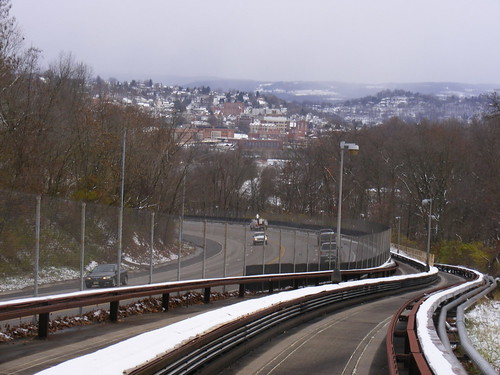
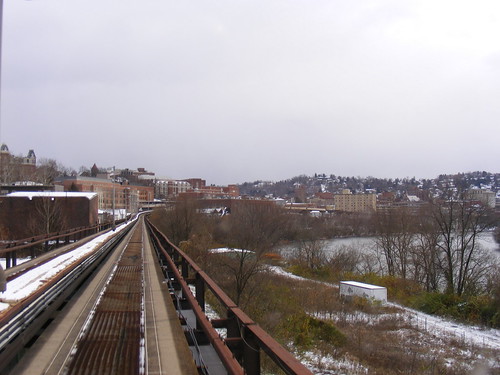

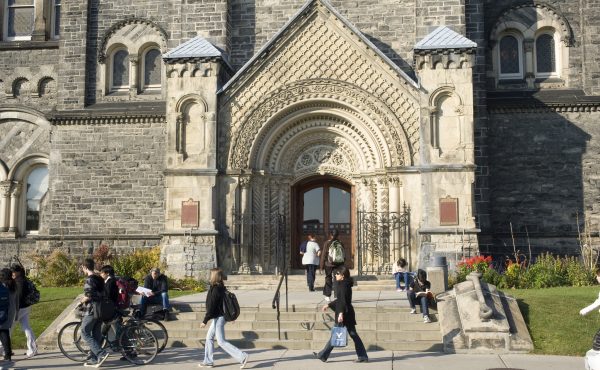
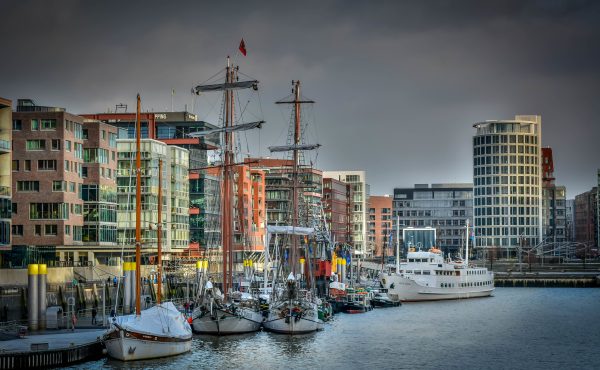
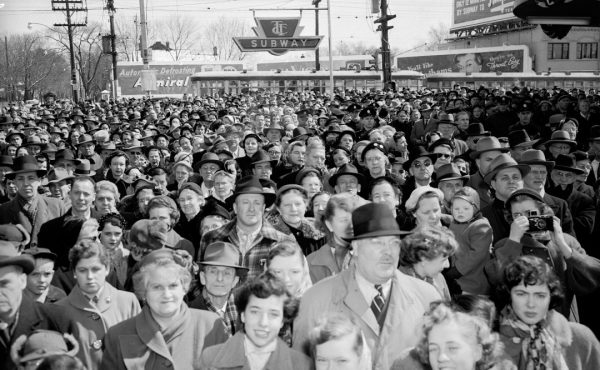
24 comments
Great, now I have John Denver signing in my head!
I honestly think that PRT is the future, distant though maybe. For those interested…..
http://faculty.washington.edu/jbs/itrans/
or for a city designed around PRT…..
http://www.masdar.ae/
This reminds me of the Wedway people mover in Disneyworld’s Tomorrowland. Or the monorail thing at Expo ’67, which I have only seen picture of (and found some concrete foundations when exploring the island — i think).
Looks (and sounds)like something from a Terry Gilliam flick:
http://en.wikipedia.org/wiki/Schwebebahn_Wuppertal
“The Althoff Circus orchestrated a publicity stunt by putting an elephant by the name of Tuffi on the train at the Alter Markt station. Tuffi became upset shortly into the ride, crashed through the left side of the car and fell into the river Wupper below. The elephant, two journalists, and one passenger received minor injuries. Both the operator and the circus director were fined after the incident. To this day, the wall of a building at the location of the event (in-between the stations Alter Markt and Adlerbrà ¼cke) shows a painting of a jumping elephant.”
http://www.youtube.com/watch?v=9hpBfzN5jqs
Interesting concept. But would it work in a city the city of Toronto?(*or any like this)
A friend here told me they’re building a similar thing in Brasil. It’d be interesting to see if they can build a PRT in a city the size of Sao Paolo. Then, just maybe, Toronto can hope on the “future” wagon and build something inovating that’ll last.
And thanks to Glen for that link to the energy company Masdar in the UAE. That (little) country never seize to amaze me with their forward thinking.
Excuse my typing 🙂
*In a city the “size” of Toronto.
**Toronto can “hop” on the band-wagon.. and “innovating”.
Cheers!
Wow. I’ve heard there are plans to build a PRT at Heathrow airport. (may already be in process or done). I absolutely adore these types of urban anomalies.
This is the sort of thing that Go Urban, eventually the RT technology, was planned to be. Small cars handling point to point trips. The idea is a total croc for large volumes of demand where line-haul is the only way to accommodate the passengers.
Note the station with its passing track. This sort of four track arrangement, if it were up in the air, would cover a city street side to side once you include the platforms and access ways. Just the sort of thing we need running down the middle of our city streets.
Sean’s other photos show the line running beside a road and alongside a river through parkland, both cases notably without station structures.
Artists renderings of “slender guideways” on streets like Queen and Spadina were part of the bilgewater pumped out by the original GO Urban publicists.
More info on Masdar’s PRT
http://mobile.mit.edu/files/cisco/masdar.pdf
That one picture (third from the bottom) shows what appears to be a fairly steep incline– perhaps this is one of the reasons PRT was considered appropriate for this site? Cheaper than tunneling through for a traditional rail-based transit option? Or is the university built on a mountain?
There’s another very steep incline right at the end of the video, which I doubt a traditional metro-type vehicle could handle.
This is certainly a neat system, though it looks kind of like something I’d expect to see at Canada’s Wonderland. I have to agree that it’s difficult to see it working in a truly urban context, though.
i’ve seen this described as GRT – Group Rapid Transit, since it’s not really ‘personal’ in the sense that it is only a single person traveling.
Peter: I’ve always associated GRT with Waterloo Region’s transit service (Grand River Transit). The system is called “personal rapid transit”, even though I point out it’s not quite a pure form of the technology.
Matt: Yes, I have heard that Heathrow is installing a similar system that’s not quite ready. Since it will use smaller cars, I guess it would be closer to true PRT.
http://www.baa.com/portal/page/Corporate%5EAll+Press+Releases/4a1d6acc2fce6110VgnVCM10000036821c0a____/a22889d8759a0010VgnVCM200000357e120a____/
Steve: I didn’t know that the original GO-ALRT plan was similar to PRT, I thought it started out with small ICTS-type vehicles before going through various redesigns. Interesting!
Joel: No, Morgantown is hilly (it would not be a fun town to bike in), but not particuarly mountainous. Driving down the hill on the highway you see did not seem that steep to me. The new university is at the top of the hill. Perhaps the YouTube video linked (taken the same time as some of the photographs by a friend) might help add some perspective.
There is a scanned system description manual on the WVU web site (PDF, probably pretty large). It includes a profile that shows a maximum grade of 10%.
http://transportation.wvu.edu/r/download/18440
Wow! Great article, Sean! I’ve never seen the MPRT up close.
The 1970s was a wacky decade for transit projects in the US. Some, like the Washington Metro or BART would ultimately become successful, while others like, um, this are interesting curios. If you read transit books from the 1970s, you get the sense that these ideas were borne out of urgency (the oil crisis) and a guilt trip about neglecting public transportation almost completely during the 1950s and 1960s.
Sean, curious that the Heathrow blurb calls it a ‘world first’. First at an airport, probably, but the evidence above means it’s not the first PRT system.
Nice graphics in their video, though; while it’ll be less than appropriate format just for their Phase I (only from parking to the newest terminal), it will make more sense when they expand to other terminals and local spots.
Thanks for this — the photos are great.
Why anyone would want to introduce choice on a fixed-route system is beyond me. I understand that they thought making the travel more customized and faster would better approximate cars and get people to switch to PRT, but that is a deeply flawed theory for more reasons than can be listed here.
Speaking of inefficient rail travel, there is a another flawed subway concept that would make for some fun Spacing reading — express subways. Not too many cities have them, but I ride one every day and I’m convinced that they are a complete waste and create a net negative time savings. Rail travel is fast enough that you never win by bypassing stations — you just add to the cost of construction and add inefficiency to the system though transfers and extra waiting time.
I dunno, when I got the A express to or from Utica Station in deep Bedstuy, all’s I thought was “YES”.
The Transportation Research Board(TRB) considers the People Mover to be a Automated Group Rapid Transit, and not to be true PRT. The AGRT designation is mainly due to the capacity of the MPM vehicles(21), compared to conceptual PRT vehicles(2-4).
I read this paper a couple of years ago on the system:
http://www.cities21.org/morgantown_TRB_111504.pdf
“The 1970s was a wacky decade for transit projects in the US.”
It was a wacky decade for a lot of things.
Is this an early cinematic representation of PRT? (fast forward to around 2:07)
http://www.youtube.com/watch?v=1f4QvqtmKJ4&feature=related
True express trains (like the Paris RER) of course are fine, but my issue is with “express” trains that interline with locals, or with systems like WVU’s that feature station bypasses. All those switches and crossovers slow trains down, lowering average speed. Often they have to wait for a train in front of them that is joining the line, adding further delay. Expresses often also wait for connecting locals in the station, which wipes out the time gain in taking the express. Finally, giving people choice also usually leads to the wrong decision, as they will wait for an express rather than take the local that is already in the station (waiting time is never factored in correctly in people’s choices). Meanwhile, the people on local platforms can’t board the express train that is passing them by, so they lose too. Do express trains add capacity? Sure. Save time for the people on it? Only if their trip is very long, at rush hour, when boarding time slows the locals. Saves time for all riders combined? Probably not.
Go ahead and try this experiment on Google Maps/Transit — go from 250 W 59th St to 550 W 215th St. in NYC (a distance comparable to Union to Sheppard). Google will tell you to that the 1 (a local) takes exactly as long as the A (an express for most of the way.) No difference in time despite the 10 extra stops. http://snurl.com/8w8st
The beauty of a fixed route is that you can just shovel the traffic down it, one after the other. Introducing choice and complexity takes this away. It’s much more efficient to be like Toronto and just cram the trains as tight as possible on one track, making every stop, fast as possible. PRTs and other complex rail setups just don’t make sense to me.
I live in Morgantown. In a town where there is not nearly enough parking, the PRT is a great thing.
FYI: The current enrollment of WVU is 26,500. PRT construction started around 1969. It took way more than a year to build.
The construction of the PRT got me out of lots of classes. Pile drivers drown out professors every time. I should have asked for a tuition credit.
Stan, WVU class of 1973.
Toronto has it’s very own gadgetbahn, “The SRT – Scarborough Rapid Transit”. I call it the S-POS (Scarboro Piece of S…) Light rail capacity at a full heavy rail price. The Linear Induction Motors + skateboard sized wheels combine to provide a rough, noisy ride with energy efficiency less than that of a 1907 model IRT (Interborough Rapid Transit) subway train.
This is mal-practice in the engineering profession and such mal-practice continues to this day in the transit establishment.
As for express trains in New York, in spite of the Cabbage-Headz that control the MTA, expresses greatly increases the capacity of the network and could also decrease rider time if real management was in place instead of the Cabbage. i.e. the locals held for connecting express trains rather than vice versa.
Lets see, McCormick-Rankin will convert the Ottawa ON busways into PRT; replace 40 and 60 foot buses with GM/Ford/Chrysler mini-vans. Big consulting contracts for M-r and the concrete-aggregate guyz will get fat widening all of the “infrastructure” to 4 (or more) lanes. Don’t forget the big contract to Accenture for fare and dispatching systems. I can just imagine the snorefest when MTO pulls out the MS-PowerPoint -tm presentations on this one….
The PRT is a white elephant–not only extremely expensive to build, but also to maintain and operate each year. Not only technical upkeep, but it is labor intensive. It was an experiment sold to the federal government but is far less practical, efficient and cost-effective than the decent bus system which preceded it, and which now augments it. It would have been far, far less expensive just to create a limited access route for the buses. Some have even joked that it would have been cheaper to give every WVU student a free car. But then there’s that parking and congestion problem that just gets worse each year as more students pour into an old town built for horse travel and about a tenth of today’s population. I’d like to think they’d find a far better “solution” today. –Brad, WVU Class of ’76.